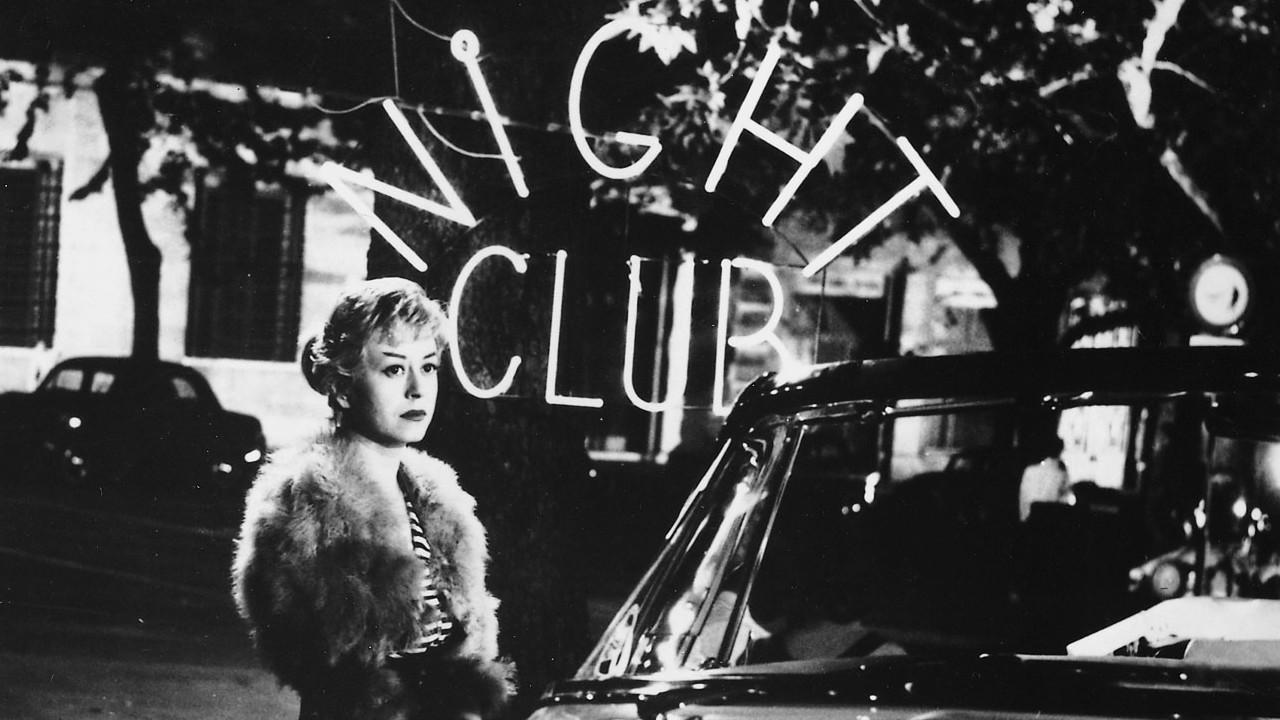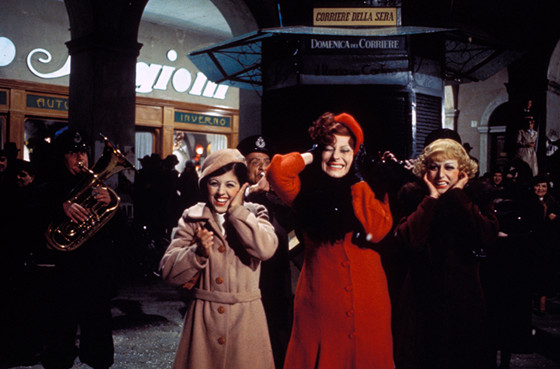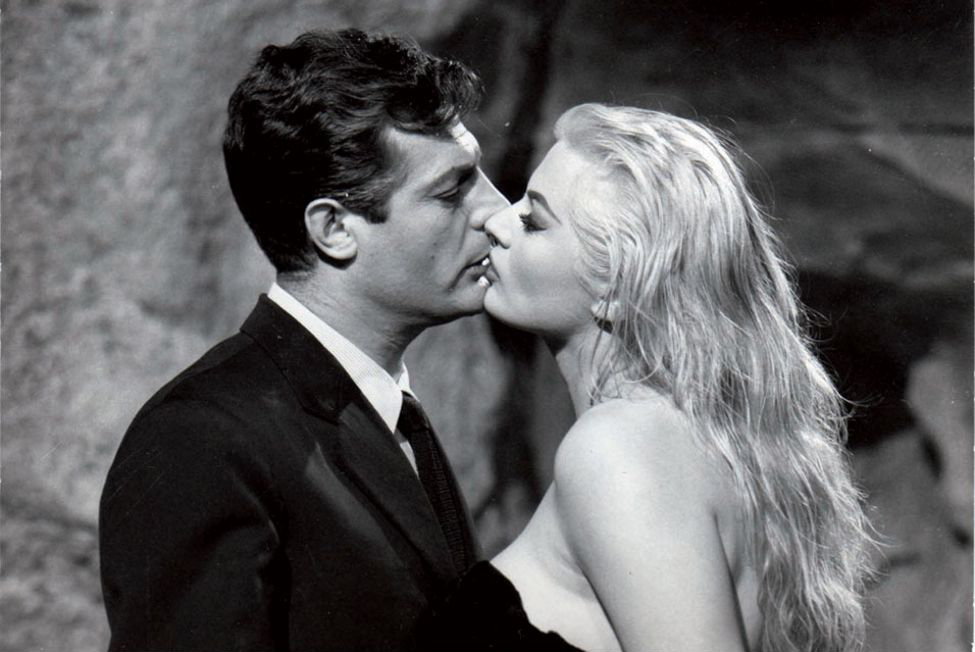6. Color or black and white
![]()
Though Fellini has made films both in color and in black and white, his visual approach in all his films remained the same: Fellini’s visual texture is extremely marked out.
In his black and white films, the visual emphasis is caused by highly contrasted images and spotted lights, especially in dream scenes, like the harem scene in “8 ½”. Guido’s distorted shadow is reflected on the bare white walls of the location; in this case, the dominant visual presence of the shadow is also an indication to Guido’s dominant character in that very scene.
However, in films like “Amarcord” and “Satyricon”, there is an explosion of colors. The usage of all these eye catching colors in one single frame is the fact that in some cases, Fellini’s works are not narratively constructed on one single protagonist, and there is more than one individual story to follow during the narration, so in some cases, visually none of the characters stand out as they are have equal narrative importance.
7. Caricatures of women

Even in films like “Le Notti di Cabiria”, where a woman is the main character and not a secondary one, Fellini’s women represent a distorted, exaggerated (in terms of makeup and attitude) figure, the very same image that later reappears in Giuseppe Tornatore’s works. The camera, in most cases, looks up at women like Saraghina; they have sexually provocative attitudes and are at the same time somewhat scary.
The little boy in Saraghina’s scene is asking Saraghina to dance the rumba, but doesn’t even have the courage to hand her the money; as soon as she gets a grip on the money, the boy dashes away frightened, and equally we stare up at Sylvia (played by Anita Ekberg) climbing up seductively from the stairs.
Fellini’s point of view in the treatment of female characters is clearly reflected in his choice of angles and lights. His camera is at eye level while having Giulietta Masina as the character; the light on Anita Ekberg is downward, marking out her angel-like, desirable figure. The source of light for Ekberg is artificial, while in Fellini’s films with Masina, the light source tends to be mostly natural.
8. Voiceover/ films as autobiographical narrations

Maybe the film that most clearly reflects Fellini’s tendency for self-narrating is “8 ½”. Famous filmmaker Guido Anselmi (played by Marcello Mastroianni) is trying to concentrate on his next film, but he is suffering from director’s block.
It seems that the film is mirroring back Fellini’s own situation – an already famous filmmaker by that time who is struggling to find a storyline. The characters like Claudia (played by Claudia Cardinale) clearly claim that they do not know anything about the role they are going to play in the film.
“Amarcord” takes place in Rimini, Fellini’s birthplace, and though there is one dominant voiceover that guides the whole narration on a pre-decided path, the film is formed by the collective method of narration; there are lots of characters involved, almost everyone has the same narrative importance, and this very fact makes the audience believe that the whole film is a two-hour point of view, a subjective poetic narration about a city that despite all its confusion is lovable. The final scene of snow on the beach plainly reflects the emotional approach of the filmmaker toward the location.
The same approach is notable in Giulietta Masina’s presence in Fellini’s films. He loves this woman so much that he cannot practically note her physical imperfections. Masina is a small woman, and probably not the first choice in a story like “Le Notti di Cabiria” if the film were directed by any other filmmaker but Fellini.
9. Narrative improvisation (Fellini versus Antonioni):

The reason for confronting two filmmakers with two completely different narrative styles is the fact that Antonioni is maybe the Italian filmmaker most famous for pre-designing his visual compositions and working strictly on the basis of the screenplay.
Every line of the dialogues in his films has been performed with respect to the very written version of the story, while in a Fellini film, the story clearly takes form while filming. “8 ½” plainly describes that the main storyline of the film is “searching for a storyline”: the conversation of Guido (Mastroianni) and Claudia in the car is just the repetition of the conversation that Fellini has had previously, before shooting, with Claudia Cardinale.
This approach toward the narration also mirrors back the already achieved fame and confidence of the filmmaker. He undoubtedly has followed the predicted written screenplay in “Le Notti di Cabiria” and “La Strada”, but “8 ½” is based on his own formed character as one of best known filmmakers of his time.
10. Dubbing

Oddly, most of neorealist Italian films have been dubbed, though it is quite contradictory with the spirit and the technical rules of Neorealism. It is still extremely common to separate the main soundtrack of the non-Italian language films and dub the whole dialogues. Some filmmakers have justified dubbing their films ideologically.
Precisely, Pier Paolo Pasolini declared that he prefers to use dubbing and use a different voice for an already known actor to un-familiarize him or her, and in this way, making the character unique and different from any other role that the actor had played beforehand.
In Fellini’s case, it seems that he simply gives priority to the visual composition; it doesn’t mean that he does not care about the sonorous part of the narration, it means that he probably did not intend to lose a perfect visual composition because of the improper sonorous conditions.
In all his films, the ambient sound is extremely isolated. Clearly not the recorded sound in the scene, the amount of sound effects is limited only to those that are meaningful in the narration and in some cases, as with lots of other Italian films of that time, the quality of the sound remains constantly high although the geographical distance and the ambience of that very visual composition do not concord with the sonorous representation.
Author Bio: Maryam Raz is a freelance filmmaker and screenwriter. La Mite based on The Gentle Spirit of Dostoyevsky is her most recent work.